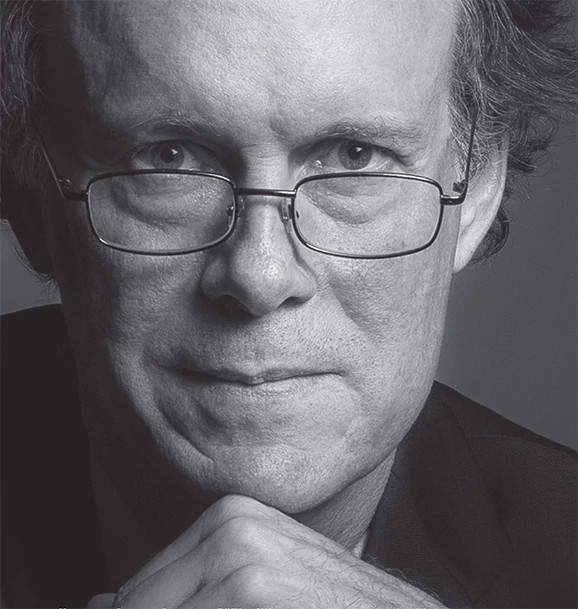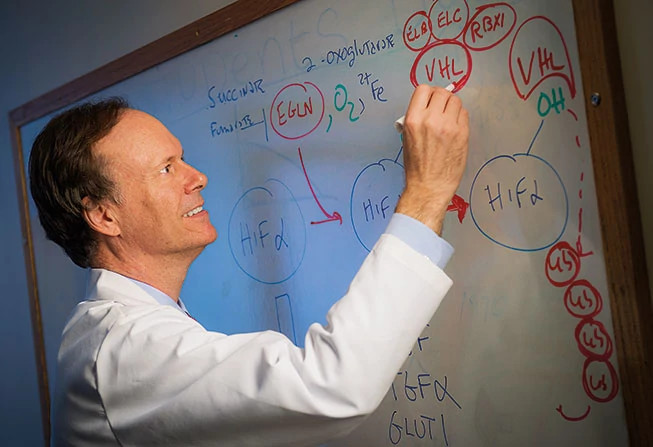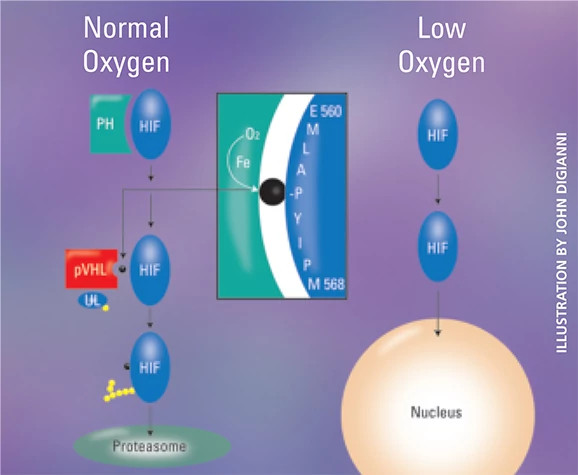How Cells and Tissues Sense Changes in Oxygen Availability
William G. Kaelin Jr., MD, explains how cells sense changes in oxygen availability.
From Paths of Progress Fall/Winter 2012
by Richard Saltus
Initially, Dana-Farber's William G. Kaelin Jr., MD, thought he would be a full-time doctor. He loved the puzzle-solving challenges associated with clinical medicine and the gratification of treating patients. He was intrigued with cancer biology from an early age and had also contemplated a laboratory-based career. But some discouraging experiences in the lab – one lab closed down four months after he moved in – led Kaelin to decide he was better suited to taking care of patients.

"I was getting sign after sign that laboratory research was not for me," he says.
However, a sobering year on the front lines of cancer care proved a powerful eye-opener – and a reminder of what drew him to research in the first place.
"It became painfully clear that the treatments we had were inadequate," says Kaelin of that period, more than 20 years ago. "But at the same time there was an explosion in cancer biology, with the potential to have a deeper molecular understanding of cancer, and to translate that knowledge into more-effective therapies."
He returned to the lab with a renewed sense of purpose, committed to using genetic tools to go after major cancers that had resisted most therapies and remained poorly understood.
It was the beginning of Kaelin's prominent career as a cancer biologist and as an adviser on cancer research, not just among his colleagues and collaborators at Dana-Farber, but also in government science circles (such as the National Cancer Institute), high-level scientific meetings, and the boardrooms of drug companies that are trying to figure out what the next generation of cancer drug targets should look like.
What makes Kaelin particularly effective, colleagues say, is an unusual gift for seeing the essence of the problem and crystallizing a discussion with a penetrating comment or question.
"He sees things more clearly than other people," says Barrett Rollins, MD, PhD, Dana-Farber's chief scientific officer. "You're in a seminar and Bill will raise his hand and ask a question and you think, why didn't I see that or ask that?"

Kaelin serves on the Institute's Executive Committee for Research, where, Rollins says, "He brings to the table a rational view of what we should be doing with our resources at Dana-Farber – and he does the same thing for the cancer research community at large."
Kaelin's accomplishments and promise have been recognized across the scientific community. The Howard Hughes Medical Institute, a major non-government supporter of cutting-edge biomedical research, named him an Investigator in 1998 and funds a portion of his laboratory. He is also a member of the National Academy of Sciences and the Institute of Medicine. Recently, Kaelin received two prestigious awards for a landmark discovery about how cells sense oxygen, and how that mechanism is hijacked in kidney cancer.
Kaelin, who joined Dana-Farber faculty in 1991, projects intensity. Tall and rangy, with slightly graying hair and a youthful face, his eyes convey clarity and focus. His manner and speech are precise and terse, yet tinged with a dry sense of humor. He can seem intimidating, quick to home in on flaws when his postdoctoral fellows and students present research updates.
"It's something you get used to," sighed one postdoc after running a gauntlet of sharp questions from his mentor.
Kaelin's precision has been honed by nearly 25 years of focused cancer research. He came to Dana-Farber for an oncology fellowship in 1987, when he saw patients in the clinic and was drawn back to laboratory research. Not only had he realized that patients above all needed new treatments based on biological research findings, but he had the "sheer luck," he says, of joining the lab of David Livingston, MD. "He was the ideal mentor and it was the ideal environment to work on important and interesting problems," Kaelin says.
How Cells and Tissues Sense Changes in Oxygen Availability
William G. Kaelin Jr., MD, explains how cells sense changes in oxygen availability.
Livingston, who now heads the Executive Committee for Research, is known for research on tumor suppressor genes, including the RB gene which, when mutated, causes retinoblastoma, a childhood eye cancer. Tumor suppressor genes produce proteins that halt the growth of damaged cells before they can form tumors. In cancer, mutations in these genes are often responsible for out-of-control cell growth.
In Livingston's lab, Kaelin isolated a protein called E2F, which promotes cell proliferation. E2F is normally kept in check by the RB tumor suppressor protein, but cells harboring a mutant RB divide uncontrollably, leading to retinoblastoma tumors.
In 1992, Kaelin, now in his own laboratory, read about the isolation of VHL, a tumor suppressor gene which is mutated in a cancer syndrome called von Hippel Lindau disease. Kaelin knew about the syndrome from his clinical training. Patients with von Hippel Lindau typically develop kidney and other cancers that, curiously, involve an overproduction of red blood cells and new blood vessels. To Kaelin, it looked like the cancers were acting as if they were low in oxygen – although they were not.
Studying VHL led Kaelin to his most acclaimed discovery – identifying the molecular explanation to a long-standing biological puzzle: How does the body sense and adapt to changes in oxygen – for example, when people adjust to thinner air at high altitudes?
Pursuing this question, he discovered that the VHL protein normally helps regulate the levels of an oxygen-sensitive protein called HIF, which can trigger or suppress the production of red blood cells and the formation of new blood vessels, and discovered the molecular switch that renders HIF oxygen-sensitive. Cancer cells with mutated VHL genes commandeer this system to surround themselves with new blood vessels – a process called angiogenesis – to feed their growth.
Kaelin's insights in the mid-1990s, along with findings by two other scientists, earned the trio the 2012 Canada Gairdner International Award and the Grand Prix of the Fondation Lefoulon-Delalande from the Institute of France in June 2012, for contributions to the field of cardiovascular research.

"Discovering the molecular basis of oxygen sensing by cells has turned a whole field's head around," comments Livingston. It has already led to experimental therapies being tested for treating cardiovascular diseases like heart attack and stroke, and potentially anemia as well.
Moreover, Kaelin's linking of VHL to the overproduction of blood vessels led him to propose treating kidney cancer with drugs that block angiogenesis. They are now approved for kidney cancer.
The oxygen-sensing mechanism "turned out to be simpler than many anticipated; there were a number of competing theoretical models, and they were much more complicated," Kaelin said. The mechanism, in fact, involved a type of chemical modification that had never before been observed in a cell.
The Kaelin lab continues to study tumor-suppressors as a window into the biology and behavior of cancer and a strategy for next-generation therapies. For example, it might be possible to develop drugs that mimic the behavior of a tumor-suppressor protein. It might also be possible to design methods of killing only cells in which a particular tumor suppressor protein has been inactivated (thus sparing normal cells).
Kaelin remains optimistic that cancer research is moving in the right direction, and though progress has been incremental, brighter days lie ahead.
"We're at a critical point with targeted therapies – exactly where we were with TB and AIDS, when we could only treat those diseases with single agents," he observes. "I'm stunned when people are surprised that success with new single targeted drugs is so short-lived. Anyone would have predicted that.
"There's no question that we're on the right track with targeted therapy," he adds. "But we have to combine those therapies and use them earlier."
Given the high esteem in which Kaelin's ideas are held, his optimism should be reassuring.
Receive by mail the current issue of a Dana-Farber publication by completing this request form.
If you are a journalist and have a question about any of our stories or need more information, email media@dfci.harvard.edu or call 617-632-4090 and ask to speak to a member of the media team.
The Media Team cannot respond to patient inquiries. For more information on contacting Dana-Farber, please see Contact Us.